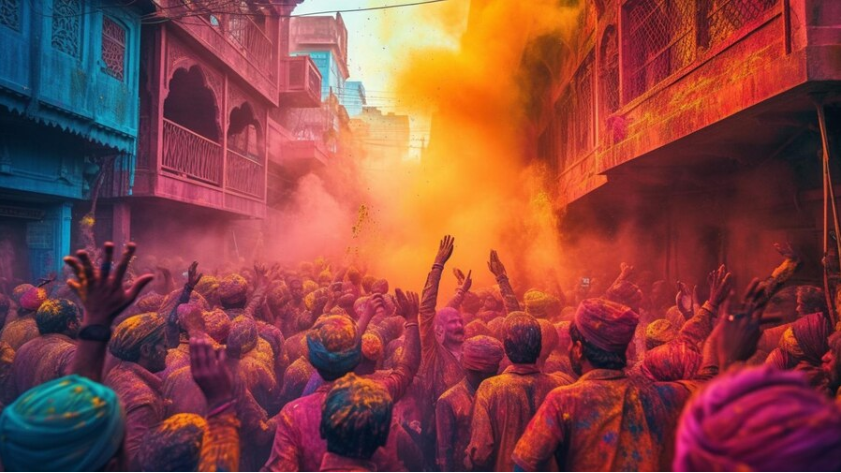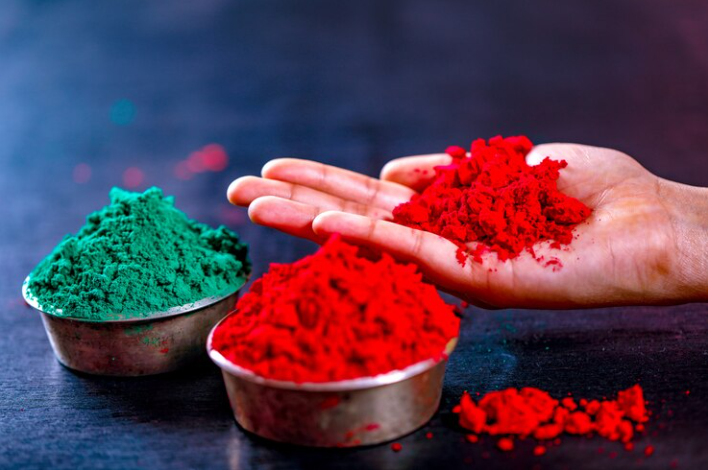
Introduction
Holi, also known as the “Festival of Colors,” is a vibrant and joyous celebration that takes place annually in India and around the world. It’s a day when people come together to revel in the triumph of good over evil and the arrival of spring. This article will take you on a colorful journey through the essence of Holi 2023, its significance, preparations, and the ways it is celebrated.
The Significance of Holi
Holi, a significant Hindu festival, is celebrated for a variety of reasons deeply rooted in Hindu mythology and tradition. Here are some of the key reasons for celebrating Holi according to Hindu beliefs:
- Victory of Good Over Evil: Holi commemorates the victory of good over evil, a theme prevalent in Hindu mythology. One of the central legends associated with Holi is the story of Prahlad and Holika. Prahlad, a devoted follower of Lord Vishnu, was saved from the evil intentions of his demoness aunt, Holika, who had a special power to resist fire. Holika attempted to burn Prahlad alive, but divine intervention protected him, and she was consumed by the fire instead. This story symbolizes the triumph of righteousness over wickedness, a core tenet of Hinduism.
- Arrival of Spring: Holi is celebrated at the onset of spring, which is a season of renewal, growth, and rejuvenation. The colorful blossoms and the return of vibrant hues to nature signify the changing of seasons and the awakening of life. Holi is a way of welcoming and celebrating this season of hope and positivity.
- Cultural Tradition: Holi is deeply ingrained in Hindu culture and traditions. It is a festival that has been celebrated for centuries and is an integral part of the Hindu religious calendar. It reflects the rich cultural heritage and practices of the Hindu community.
- Religious Significance: Many people celebrate Holi as a religious observance. On the eve of Holi, a bonfire is lit, symbolizing the burning of evil forces and the purification of the environment. It also serves as an opportunity for devotees to offer prayers to deities and seek blessings for the year ahead.
- Social Harmony and Unity: Holi promotes social harmony and unity. During the festival, people of all backgrounds come together to play with colors, breaking down barriers of class, caste, and creed. The festival reinforces the idea of a harmonious and equal society where differences are forgotten, and everyone participates in the revelry.
- Expressing Love and Affection: One of the joys of Holi is the tradition of applying colors to one another. It’s a way of expressing love and affection for family and friends. Holi provides an opportunity to mend relationships, bridge gaps, and create stronger bonds with loved ones.
- Rejoicing and Letting Loose: Holi is a time to let loose and enjoy life to the fullest. It encourages people to shed inhibitions and celebrate with unrestrained enthusiasm. The playful throwing of colors and water balloons is an expression of this joyful spirit.
In summary, Holi holds immense significance in Hinduism as a festival that celebrates the victory of good over evil, the arrival of spring, and the fostering of social harmony and unity. It is a time to express love and affection, observe religious traditions, and simply revel in the joyous, colorful festivities that have been a part of Hindu culture for generations.
Preparations and Traditions
Preparations for Holi commence well in advance. People engage in thorough spring cleaning of their homes, symbolizing the removal of negative energies and the welcoming of positivity. New clothes are purchased, symbolizing the start of something fresh and the shedding of the old. The festival’s eve is celebrated with a bonfire, signifying the destruction of evil forces and the purification of the environment.
On the day of Holi, the real festivities begin as people come together, armed with a variety of colored powders and water. Friends and family gather in open spaces, smearing each other with colorful gulal and drenching one another with water balloons. The streets are painted in an array of vibrant hues, and laughter fills the air. The tradition of applying colors signifies the breaking of social boundaries and promotes unity, where everyone is equal in the playful chaos of colors.

Importance of Colors
Colors are of paramount importance in the celebration of Holi, and they hold multiple symbolic and cultural significances:
- Symbol of Joy and Happiness: The vibrant colors used during Holi are a visual representation of joy and happiness. The festival is all about spreading cheer and merriment, and the colors reflect this exuberance.
- Sign of Spring: Holi is celebrated at the cusp of winter and spring, and the colors are a vivid representation of the arrival of this colorful and blossoming season. They signify the renewal of life and nature.
- Symbol of Unity: Holi transcends social, caste, and class distinctions. People from all walks of life come together to play with colors, breaking down barriers and promoting unity. In this context, colors represent the idea of a harmonious and equal society.
- Cultural and Religious Significance: Holi has deep cultural and religious roots. The colorful powders used in Holi are considered to be a form of offering to deities, and they symbolize the triumph of good over evil.
- Expression of Love and Affection: During Holi, people apply colors to one another as a form of expressing love and affection. It’s an opportunity to mend relationships, bridge gaps, and create stronger bonds with friends and family.
- Freedom and Playfulness: Holi provides a sense of freedom from societal norms and inhibitions. The playfulness with colors represents breaking free from constraints and embracing spontaneity.
- Aesthetic and Cultural Tradition: The artistic use of colors, both dry powders and colored water, is an integral part of Holi’s aesthetic and cultural tradition. It’s a form of creative expression that adds to the festival’s beauty.
- Gastronomic Significance: The colors of the various traditional Holi sweets and snacks, like gujiya and thandai, add to the overall gastronomic experience of the festival. These colorful dishes not only taste delicious but also contribute to the festive ambiance.
In essence, colors are the soul of Holi. They infuse the festival with energy, love, and a sense of cultural identity. Holi’s playful and colorful nature makes it a unique and beloved celebration, drawing people from all over the world to partake in the joyous revelry.
Delicious Holi Delicacies
Delicious Holi delicacies are an integral part of the Holi festival, adding a flavorful and indulgent dimension to the celebrations. These special dishes are prepared with love and care and are eagerly anticipated by people during it. Here’s an explanation of some of the delectable Holi delicacies:
- Gujiya: Gujiya is a classic Holi sweet that is widely enjoyed during the festival. These crescent-shaped dumplings are filled with a sweet mixture of khoya (reduced milk), nuts, and aromatic spices. They are often deep-fried until golden brown, creating a crisp outer layer that contrasts beautifully with the rich and creamy filling. Gujiyas are traditionally made in many Indian households, and their sweet, nutty taste is a beloved part of Holi celebrations.
- Thandai: Thandai is a cool and refreshing drink that is synonymous with Holi. It’s a flavored milk beverage made with a mixture of various ingredients, including almonds, fennel seeds, rose petals, cardamom, and saffron. Thandai is known for its ability to cool the body, making it a perfect accompaniment to the festivities, especially on a day when people play with colors under the sun. It is often garnished with a sprinkle of crushed pistachios and almonds.
- Puran Poli: Puran Poli is a sweet flatbread that is particularly popular in the western regions of India during Holi. It is made by stuffing a wheat flour dough with a sweet filling made from chana dal (split chickpea lentils), jaggery, and fragrant spices like cardamom and nutmeg. The combination of the sweet filling and the soft, chewy bread is both comforting and delightful.
- Aloo Tikki: While not a sweet dish, aloo tikki is a savory Holi delicacy enjoyed by many. It consists of spiced mashed potatoes shaped into patties and shallow-fried until golden and crispy. Aloo tikki is often served with a variety of chutneys and yogurt-based sauces, creating a flavorful and satisfying snack for Holi gatherings.
- Mathri: Mathri is a crispy and flaky snack that’s a Holi favorite, particularly in North India. These deep-fried, savory pastries are made from a mixture of refined flour, ghee (clarified butter), and spices. The result is a delightful snack that pairs perfectly with tea or as a quick munch during Holi celebrations.
- Jalebi: Jalebi is a popular Indian dessert made by deep-frying a wheat flour batter in a spiral or pretzel shape. The fried jalebis are then soaked in a sugar syrup, which gives them their characteristic sweet and sticky texture. During Holi, jalebis are often served alongside other sweets, providing a delightful contrast of flavors and textures.
These delicious Holi delicacies not only tickle the taste buds but also play a significant role in creating a festive and indulgent atmosphere during the celebration. They are a testament to the rich culinary traditions of India and add to the overall joy and merriment of the Holi festival.
Celebrating with Family and Friends
Holi is a time for reuniting with family and friends. People exchange greetings, sweets, and gifts. Playing it with loved ones creates lasting memories and strengthens bonds.
Holi Celebrations Worldwide
In recent years, Holi has transcended its Indian origins and gained popularity worldwide. Many countries now celebrate Holi, turning it into a symbol of unity in diversity. It’s a testament to the global appeal of this festival, which welcomes people of all backgrounds to join in the festivities.
Unique Celebrations in India
Different regions of India have their unique ways of celebrating Holi. For example, in Mathura and Vrindavan, the birthplace of Lord Krishna, Holi celebrations are legendary. The towns are known for their grand processions, classical music and dance performances, and the throwing of colors. In West Bengal, it is celebrated as Dol Jatra or Dol Purnima, with the central focus on the idols of Radha and Krishna. These regional variations showcase the rich cultural diversity of India and its various interpretations of Holi.
Modern Celebrations Of It
In the age of social media, Holi celebrations have taken on a modern twist. People use the occasion to share their colorful moments with the world, creating a digital splash.

Staying Safe During Holi
While Holi is a day of unrestrained fun, it’s essential to celebrate responsibly.
Protecting Your Skin and Eyes
Using organic and skin-friendly colors is crucial to prevent skin allergies and irritation. Wearing sunglasses can shield your eyes from the splashes of colored water, keeping them safe and comfortable throughout the celebrations.
2.Responsible Water Usage
Holi is known for its water balloon fights, but it’s important to conserve water and avoid excessive wastage. Practicing water conservation can make Holi both enjoyable and eco-friendly.
The Spirit of Unity
Holi is not just about colors; it’s a festival that transcends barriers of class, caste, and creed.
Breaking Barriers
Holi is a powerful example of how people from all walks of life come together to celebrate. During Holi, social distinctions blur, and everyone, regardless of their background, participates in the revelry, reflecting the true spirit of unity.
2. Holi – A Unifying Festival
Dhuleti showcases the rich cultural diversity of India, bringing everyone under one colorful umbrella. It symbolizes the oneness of humanity, where people come together to enjoy the festival, emphasizing that diversity can be a source of strength and joy.
Conclusion
In conclusion, Holi 2023 promises to be a vibrant and memorable celebration filled with colors, traditions, and togetherness. It’s a day to forget differences, enjoy the thrill of colorful chaos, and strengthen bonds with loved ones. Holi is not just a festival; it’s an experience that fosters unity and joy.
Frequently Asked Questions (FAQs)
Q1: When is Holi 2023? Holi in 2023 falls on March 10th and 11th.
Q2: Can anyone participate in Holi celebrations in India? Absolutely! Holi is a festival for everyone, and tourists are welcome to join in the festivities.
Q3: Are Holi colors safe for the skin? It’s essential to use organic colors to prevent skin allergies.
Q4: What is the best place to experience Holi in India? Mathura and Vrindavan are renowned for their grand Holi celebrations.
Q5: How do people wish each other on Holi? People exchange greetings like “Happy Holi” and often hug or embrace to express goodwill and affection.
External Link
- Internal Link
- Importance Note
We have taken all this information from internal and external sources. We do not guarantee that all information is correct. There is a possibility that some information is wrong. We will not be responsible for any wrong information.


